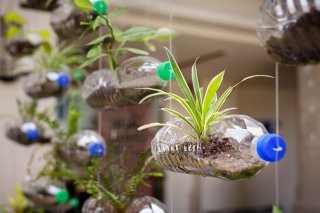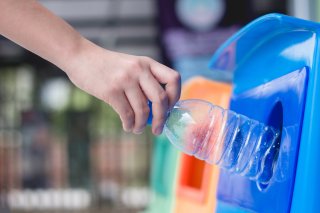What You Can Do to Reduce Plastic Waste
We can all help to reduce and eliminate plastics in the environment. Find some actions you can take to help below.
On this page:
Reduce and Reuse

- The most effective way to reduce waste is to not create it in the first place, so focus on reducing your waste as much as possible.
- Set your table with cloth napkins and reusable dishes, glasses, and silverware as often as possible.
- Think green before you shop. Bring your own reusable bag for carrying your purchases, and try to buy items with minimal packaging.
- If you bring your lunch, package it in reusable containers instead of disposable ones. Read EPA's Pack a Waste Free Lunch guide for more tips.
- Bring drinks with you in a water bottle or thermos instead of disposable bottles or cartons.
- Consider putting a filter on your water tap and refilling bottles with the filtered water instead of buying bottled water.
- Instead of buying many small drink bottles, buy drink mixes in bulk and fill your reusable bottles.
- Maintain and repair plastics products, so that they won't have to be thrown out and replaced as frequently.
- Buy used plastic items to reduce plastic waste.
- Instead of discarding unwanted plastic items that are still in good shape, try selling or donating them, so others can reuse them. Choose your favorite app to post your items on for sale or free. Or find out if your local church, community center, thrift store, or school accepts a donated items.
- Baking cookies or other goodies as presents? Package them in reusable or recyclable containers.
- Reuse or repurpose items such as toys, clam shell containers, water bottles, and containers to prevent plastic waste.
For many more tips on how you can reduce waste across the board, check out our page on Reducing Waste: What You Can Do.
Recycle

- Recycle all of the plastic you can in your life:
- Know before you throw. Some types of plastics are not accepted in community recycling programs. Check with your local recycling program to find out which types of plastic they accept.
- The symbols on the bottom of plastic bottles and containers identify the type of plastic used to make the container. This can help you determine whether the item is recyclable by your local program. The resin number is contained in a triangle that looks very similar to the recycling symbol. However, this symbol does not necessarily mean it can be collected for recycling in your community.
- Encourage your household to recycle right and recycle more.
- Look into how to recycle plastic bags, wrap, and film in your area. These items are recyclable, but they cannot go in your household recycling bin. Ask your local grocery and department store, or visit the Earth911 to find a location nearest you that recycles plastic bags, wrap, and film.
- You can rarely recycle plastic utensils. Think about if you need them before picking up your takeout. If not, ask the restaurant to leave them out of your order. Consider washing and reusing whatever you do need.
- Compostable plastics are not intended for recycling either and can contaminate and disrupt the recycling stream if mixed with non-compostable plastics. If your community does not have a composting pick-up program that accepts compostable plastic, contact your garbage and recycling company or local government to find out if there are any drop-off locations for your compostable plastic items.
- Organize a recycling drive in your neighborhood or at school. Collect bottles and other accepted containers and take them to your local recycling center or a charity in need.
- When possible, purchase products made from recycled plastic materials.
- Moving? Use bubble wrap containing recycled plastic. Be sure to recycle packaging materials after your move.
